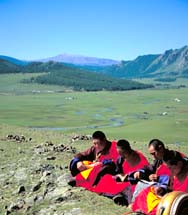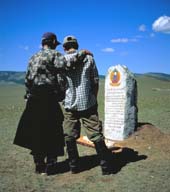Uncovering the lost sutras and ancient sacred sites of Mongolia
 |
 |
 |
a ceremony to reconsecrate a sacred landscape in Mongolia |
During the purges of the Communist era many sacred Buddhist texts disappeared. By 1989 it appeared there was almost nothing left of Mongolia’s monastery libraries. But through the 1990s, as the monasteries revived, many of these texts were rediscovered – buried or otherwise hidden by monks and lay people.
Old solutions to new problems
These texts brought an ingenious way of facing one of the great problems of Mongolia: how to reverse the decline of the rural environment caused by over-grazing, hunting, water shortage, pollution, logging and waste disposal.
Before communism, Mongolians revered their country as one of the most sacred places in the world. Its chosen protector was Avalokitesvara - the deity of compassion - and throughout the land were hundreds of holy mountains and valleys, each with a sacred text explaining why it was sacred, and how to revere it.
 |
 |
 |
a recently reinstalled stele marking a sacred landscape |
In 2002, the monks of the newly revived Gandan Monastery helped by ARC, WWF Mongolia and the World Bank, published a collection of ancient sutras, or sacred texts, entitled Sacred Sites in Mongolia. The texts describe the sacred geography and rituals of 80 sacred sites whose use had been suppressed under communism.
Reinstating the sacred sites
So far six of the most important Mongolian sacred sites have been reinstated by their local monastic communities. In Mongolian tradition, sacred landscapes are marked by standing stones, signifying that trees, animals and land in the area should be protected.
Even within 12 months there was a noticeable increase in the number of wild animals, including marmots and birds of prey. It is hoped that in the long term, with nature allowed to take its own course, the vegetation and tree cover will also return.
The project has worked because the standing stones and what they signify are backed up by the monks in each area, who carry influence with local government and nomadic communities. And WWF Mongolia add their environmental weight to the work.
The collection of ancient sutras, entitled Sacred Sites of Mongolia, was translated into modern Mongolian by Dr Hatgin Sukhbaatar, and is the first of a planned series. More than 200 other ‘lost’ sutras have now been uncovered, and will be published with the help of the World Bank.
Links to the Mongolian Buddhist Handbook
Link here to access the news story about the launch of the Mongolian Buddhist Handbook.
Link here to download the Mongolian language version of the Buddhist Handbook.(Please note this file is 2MB.)
And here to download the Mongolian Buddhist Handbook in English. (Please note this file is 1.15MB)
Link here to download the guide to the Mongolian Buddhists’ Eight Year Plan (this file is 4.13MB).
And link
here for details of ancient Buddhist wisdom on taking care of nature.
Link here for details on Mongolian Case Studies.
And
here on how to make contact with the Sangha.
To download the A3 poster of a new thangka about Buddhists protecting Nature, link
here (5.61MB).
|

